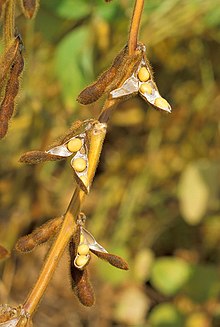
Soya flour

The soybean or soya bean (Glycine max) is a species of legume native to East Asia, widely grown for its edible bean, which has numerous uses. Traditional unfermented food uses of soybeans include soy milk, from which tofu and tofu skin are made. Fermented soy foods include soy sauce, fermented bean paste, nattō, and tempeh. Fat-free (defatted) soybean meal is a significant and cheap source of protein for animal feeds and many packaged meals. For example, soybean products, such as textured vegetable protein (TVP), are ingredients in many meat and dairy substitutes. Soy beans contain significant amounts of phytic acid, dietary minerals and B vitamins. Soy vegetable oil, used in food and industrial applications, is another product of processing the soybean crop. Soybean is the most important protein source for feed farm animals (that in turn yields animal protein for human consumption). The word 'soy' originated as a corruption of the Chinese or Japanese names for soy sauce (Chinese: 豉油; pinyin: chǐyóu; Jyutping: si6jau4; Cantonese Yale: sihyàuh) (Japanese: 醤油, shōyu). The etymology of the genus, Glycine, comes from Linnaeus. When naming the genus, Linnaeus observed that one of the species within the genus had a sweet root. Based on the sweetness, the Greek word for sweet, glykós, was Latinized. The genus name is not related to the amino acid glycine. The genus Glycine Willd. is divided into two subgenera, Glycine and Soja. The subgenus Soja (Moench) F.J. Herm. includes the cultivated soybean, Glycine max (L.) Merr., and the wild soybean, Glycine soja Sieb. & Zucc. Both species are annuals. Glycine soja is the wild ancestor of Glycine max, and grows wild in China, Japan, Korea and Russia. The subgenus Glycine consists of at least 25 wild perennial species: for example, Glycine canescens F.J. Herm. and G. tomentella Hayata, both found in Australia and Papua New Guinea. Perennial soybean (Neonotonia wightii) originated in Africa and is now a widespread pasture crop in the tropics. Like some other crops of long domestication, the relationship of the modern soybean to wild-growing species can no longer be traced with any degree of certainty. It is a cultural variety with a very large number of cultivars. Like most plants, soybeans grow in distinct morphological stages as they develop from seeds into fully mature plant.
